Management of Complex Projects: The Concorde Case Study
VerifiedAdded on 2023/06/14
|14
|3591
|238
AI Summary
This article discusses the Concorde case study and how effective knowledge management strategies can help organizations avoid similar situations. It also explores the Cynefin Model and its application in decision making.
Contribute Materials
Your contribution can guide someone’s learning journey. Share your
documents today.
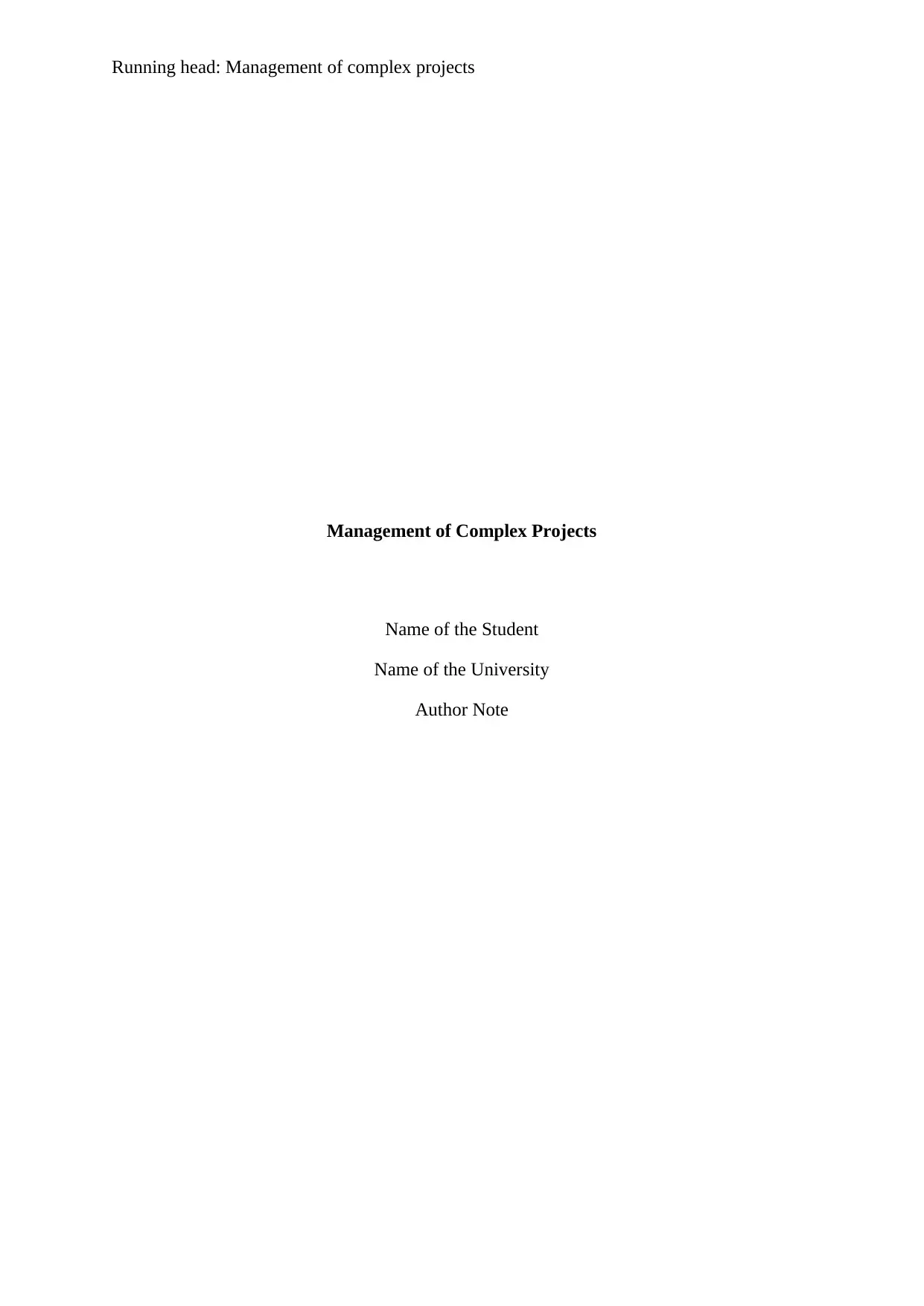
Running head: Management of complex projects
Management of Complex Projects
Name of the Student
Name of the University
Author Note
Management of Complex Projects
Name of the Student
Name of the University
Author Note
Secure Best Marks with AI Grader
Need help grading? Try our AI Grader for instant feedback on your assignments.
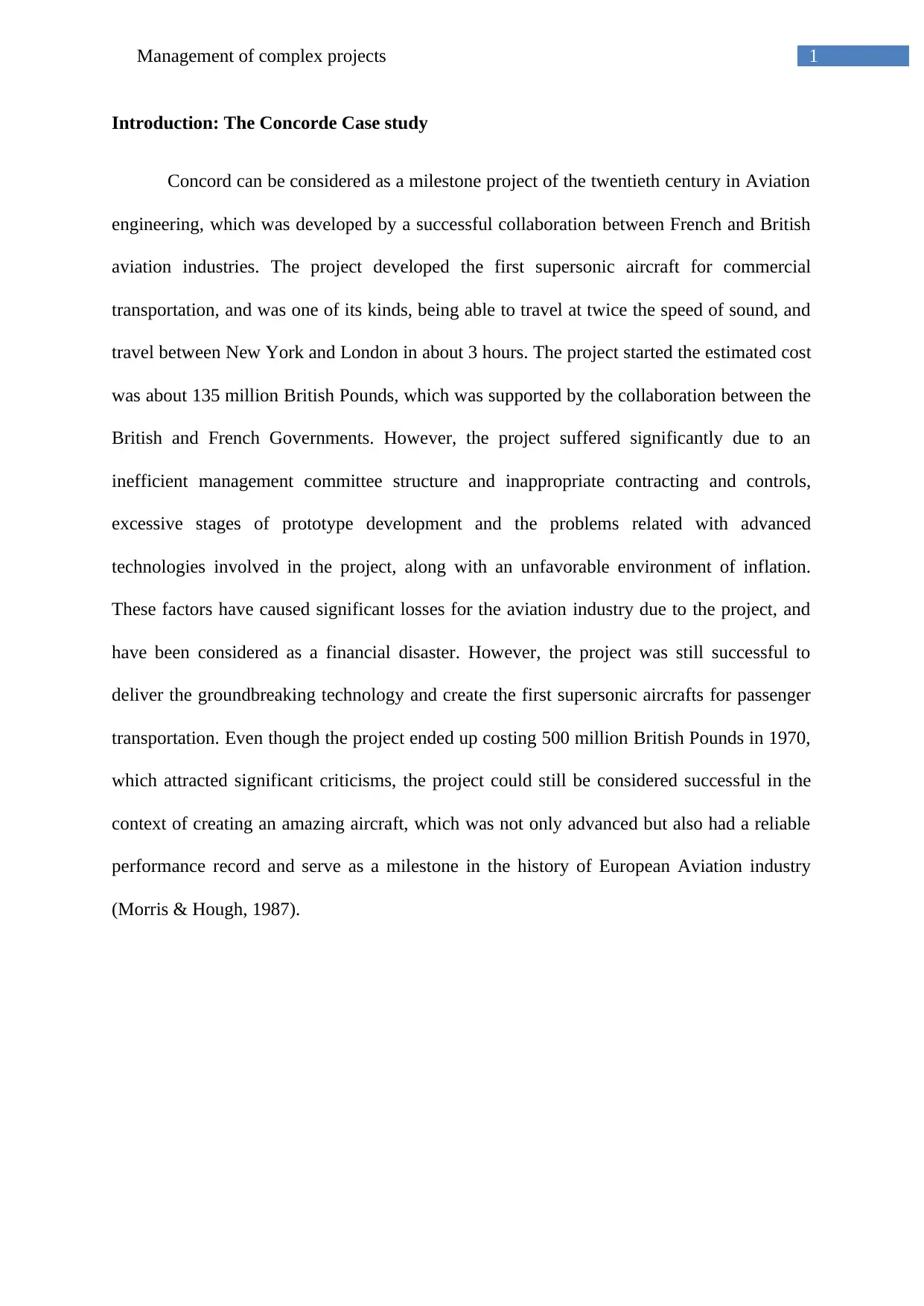
1Management of complex projects
Introduction: The Concorde Case study
Concord can be considered as a milestone project of the twentieth century in Aviation
engineering, which was developed by a successful collaboration between French and British
aviation industries. The project developed the first supersonic aircraft for commercial
transportation, and was one of its kinds, being able to travel at twice the speed of sound, and
travel between New York and London in about 3 hours. The project started the estimated cost
was about 135 million British Pounds, which was supported by the collaboration between the
British and French Governments. However, the project suffered significantly due to an
inefficient management committee structure and inappropriate contracting and controls,
excessive stages of prototype development and the problems related with advanced
technologies involved in the project, along with an unfavorable environment of inflation.
These factors have caused significant losses for the aviation industry due to the project, and
have been considered as a financial disaster. However, the project was still successful to
deliver the groundbreaking technology and create the first supersonic aircrafts for passenger
transportation. Even though the project ended up costing 500 million British Pounds in 1970,
which attracted significant criticisms, the project could still be considered successful in the
context of creating an amazing aircraft, which was not only advanced but also had a reliable
performance record and serve as a milestone in the history of European Aviation industry
(Morris & Hough, 1987).
Introduction: The Concorde Case study
Concord can be considered as a milestone project of the twentieth century in Aviation
engineering, which was developed by a successful collaboration between French and British
aviation industries. The project developed the first supersonic aircraft for commercial
transportation, and was one of its kinds, being able to travel at twice the speed of sound, and
travel between New York and London in about 3 hours. The project started the estimated cost
was about 135 million British Pounds, which was supported by the collaboration between the
British and French Governments. However, the project suffered significantly due to an
inefficient management committee structure and inappropriate contracting and controls,
excessive stages of prototype development and the problems related with advanced
technologies involved in the project, along with an unfavorable environment of inflation.
These factors have caused significant losses for the aviation industry due to the project, and
have been considered as a financial disaster. However, the project was still successful to
deliver the groundbreaking technology and create the first supersonic aircrafts for passenger
transportation. Even though the project ended up costing 500 million British Pounds in 1970,
which attracted significant criticisms, the project could still be considered successful in the
context of creating an amazing aircraft, which was not only advanced but also had a reliable
performance record and serve as a milestone in the history of European Aviation industry
(Morris & Hough, 1987).
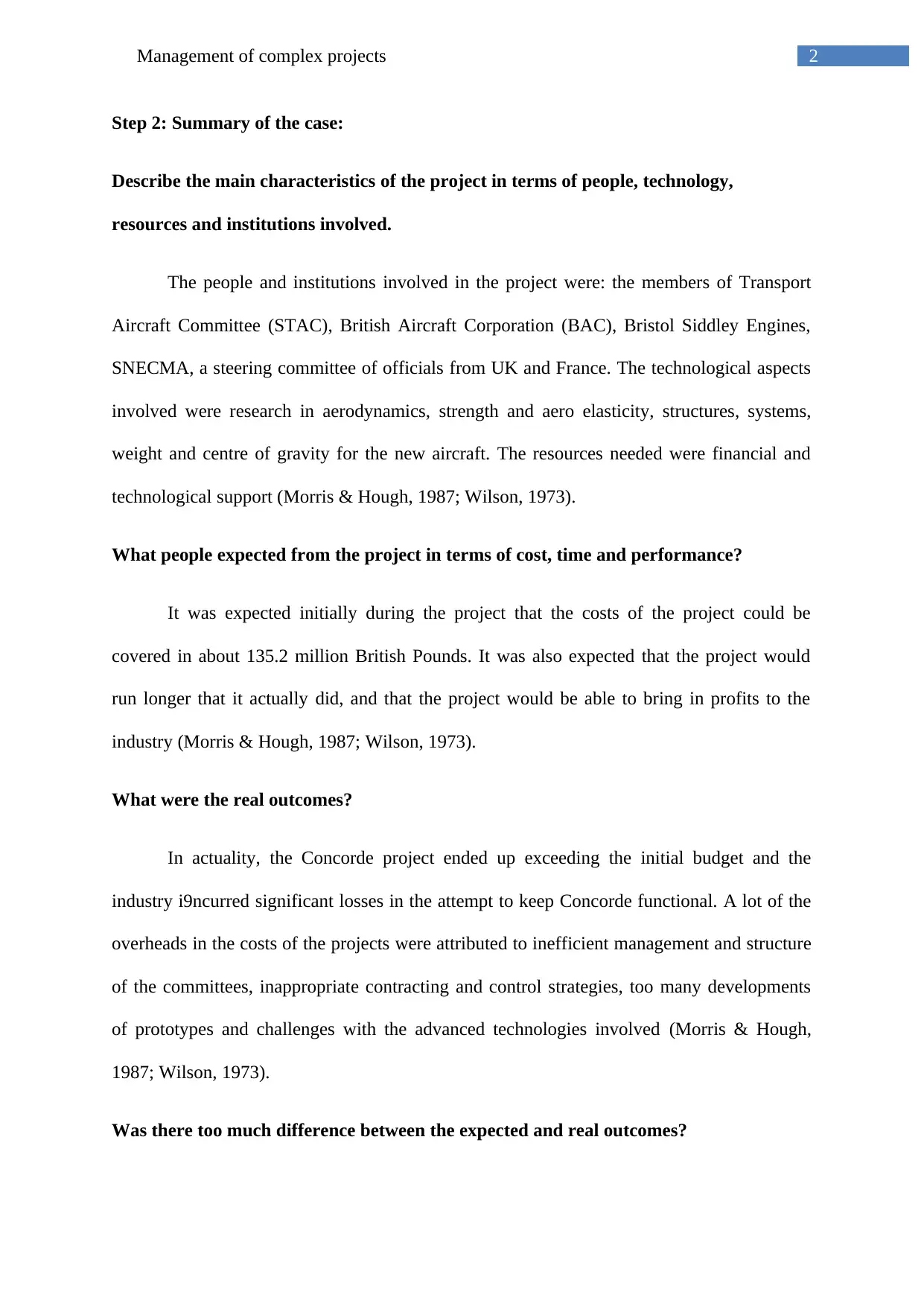
2Management of complex projects
Step 2: Summary of the case:
Describe the main characteristics of the project in terms of people, technology,
resources and institutions involved.
The people and institutions involved in the project were: the members of Transport
Aircraft Committee (STAC), British Aircraft Corporation (BAC), Bristol Siddley Engines,
SNECMA, a steering committee of officials from UK and France. The technological aspects
involved were research in aerodynamics, strength and aero elasticity, structures, systems,
weight and centre of gravity for the new aircraft. The resources needed were financial and
technological support (Morris & Hough, 1987; Wilson, 1973).
What people expected from the project in terms of cost, time and performance?
It was expected initially during the project that the costs of the project could be
covered in about 135.2 million British Pounds. It was also expected that the project would
run longer that it actually did, and that the project would be able to bring in profits to the
industry (Morris & Hough, 1987; Wilson, 1973).
What were the real outcomes?
In actuality, the Concorde project ended up exceeding the initial budget and the
industry i9ncurred significant losses in the attempt to keep Concorde functional. A lot of the
overheads in the costs of the projects were attributed to inefficient management and structure
of the committees, inappropriate contracting and control strategies, too many developments
of prototypes and challenges with the advanced technologies involved (Morris & Hough,
1987; Wilson, 1973).
Was there too much difference between the expected and real outcomes?
Step 2: Summary of the case:
Describe the main characteristics of the project in terms of people, technology,
resources and institutions involved.
The people and institutions involved in the project were: the members of Transport
Aircraft Committee (STAC), British Aircraft Corporation (BAC), Bristol Siddley Engines,
SNECMA, a steering committee of officials from UK and France. The technological aspects
involved were research in aerodynamics, strength and aero elasticity, structures, systems,
weight and centre of gravity for the new aircraft. The resources needed were financial and
technological support (Morris & Hough, 1987; Wilson, 1973).
What people expected from the project in terms of cost, time and performance?
It was expected initially during the project that the costs of the project could be
covered in about 135.2 million British Pounds. It was also expected that the project would
run longer that it actually did, and that the project would be able to bring in profits to the
industry (Morris & Hough, 1987; Wilson, 1973).
What were the real outcomes?
In actuality, the Concorde project ended up exceeding the initial budget and the
industry i9ncurred significant losses in the attempt to keep Concorde functional. A lot of the
overheads in the costs of the projects were attributed to inefficient management and structure
of the committees, inappropriate contracting and control strategies, too many developments
of prototypes and challenges with the advanced technologies involved (Morris & Hough,
1987; Wilson, 1973).
Was there too much difference between the expected and real outcomes?

3Management of complex projects
The major drawback of the project was due to the exceeding costs of the project,
however in the context of the design and performance of the Concorde airplane, the project
was a success, as was versioned by the designers, and was able to deliver performance as
expected in the project. Hence, in such aspect there was not considerable difference, however
on the financial standpoint there was a huge gap between the estimated and actual costs
(Morris & Hough, 1987; Wilson, 1973).
Who initiated the project, and why?
The project was initiated by the UK in 1956 (October) under Anthony Edence
governance, which resulted in the setup of the Supersonic Transport Aircraft Committee
(STAC). The goal was to study further in supersonic aircraft designing (Morris & Hough,
1987; Wilson, 1973).
Who were the main stakeholders of the project?
The main stakeholders were the British and French Governments and Aviation
industries (Morris & Hough, 1987)
The major drawback of the project was due to the exceeding costs of the project,
however in the context of the design and performance of the Concorde airplane, the project
was a success, as was versioned by the designers, and was able to deliver performance as
expected in the project. Hence, in such aspect there was not considerable difference, however
on the financial standpoint there was a huge gap between the estimated and actual costs
(Morris & Hough, 1987; Wilson, 1973).
Who initiated the project, and why?
The project was initiated by the UK in 1956 (October) under Anthony Edence
governance, which resulted in the setup of the Supersonic Transport Aircraft Committee
(STAC). The goal was to study further in supersonic aircraft designing (Morris & Hough,
1987; Wilson, 1973).
Who were the main stakeholders of the project?
The main stakeholders were the British and French Governments and Aviation
industries (Morris & Hough, 1987)
Secure Best Marks with AI Grader
Need help grading? Try our AI Grader for instant feedback on your assignments.
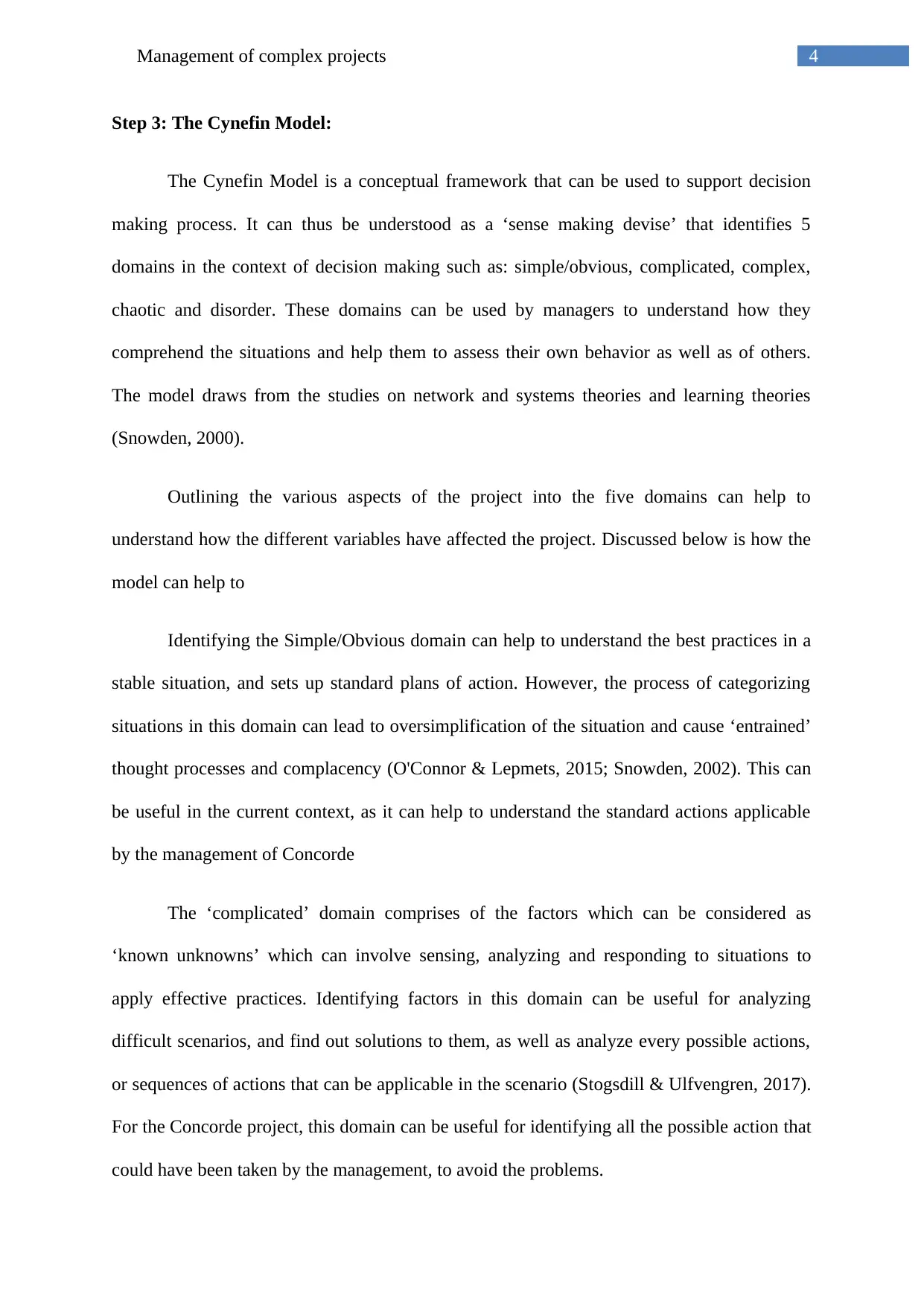
4Management of complex projects
Step 3: The Cynefin Model:
The Cynefin Model is a conceptual framework that can be used to support decision
making process. It can thus be understood as a ‘sense making devise’ that identifies 5
domains in the context of decision making such as: simple/obvious, complicated, complex,
chaotic and disorder. These domains can be used by managers to understand how they
comprehend the situations and help them to assess their own behavior as well as of others.
The model draws from the studies on network and systems theories and learning theories
(Snowden, 2000).
Outlining the various aspects of the project into the five domains can help to
understand how the different variables have affected the project. Discussed below is how the
model can help to
Identifying the Simple/Obvious domain can help to understand the best practices in a
stable situation, and sets up standard plans of action. However, the process of categorizing
situations in this domain can lead to oversimplification of the situation and cause ‘entrained’
thought processes and complacency (O'Connor & Lepmets, 2015; Snowden, 2002). This can
be useful in the current context, as it can help to understand the standard actions applicable
by the management of Concorde
The ‘complicated’ domain comprises of the factors which can be considered as
‘known unknowns’ which can involve sensing, analyzing and responding to situations to
apply effective practices. Identifying factors in this domain can be useful for analyzing
difficult scenarios, and find out solutions to them, as well as analyze every possible actions,
or sequences of actions that can be applicable in the scenario (Stogsdill & Ulfvengren, 2017).
For the Concorde project, this domain can be useful for identifying all the possible action that
could have been taken by the management, to avoid the problems.
Step 3: The Cynefin Model:
The Cynefin Model is a conceptual framework that can be used to support decision
making process. It can thus be understood as a ‘sense making devise’ that identifies 5
domains in the context of decision making such as: simple/obvious, complicated, complex,
chaotic and disorder. These domains can be used by managers to understand how they
comprehend the situations and help them to assess their own behavior as well as of others.
The model draws from the studies on network and systems theories and learning theories
(Snowden, 2000).
Outlining the various aspects of the project into the five domains can help to
understand how the different variables have affected the project. Discussed below is how the
model can help to
Identifying the Simple/Obvious domain can help to understand the best practices in a
stable situation, and sets up standard plans of action. However, the process of categorizing
situations in this domain can lead to oversimplification of the situation and cause ‘entrained’
thought processes and complacency (O'Connor & Lepmets, 2015; Snowden, 2002). This can
be useful in the current context, as it can help to understand the standard actions applicable
by the management of Concorde
The ‘complicated’ domain comprises of the factors which can be considered as
‘known unknowns’ which can involve sensing, analyzing and responding to situations to
apply effective practices. Identifying factors in this domain can be useful for analyzing
difficult scenarios, and find out solutions to them, as well as analyze every possible actions,
or sequences of actions that can be applicable in the scenario (Stogsdill & Ulfvengren, 2017).
For the Concorde project, this domain can be useful for identifying all the possible action that
could have been taken by the management, to avoid the problems.
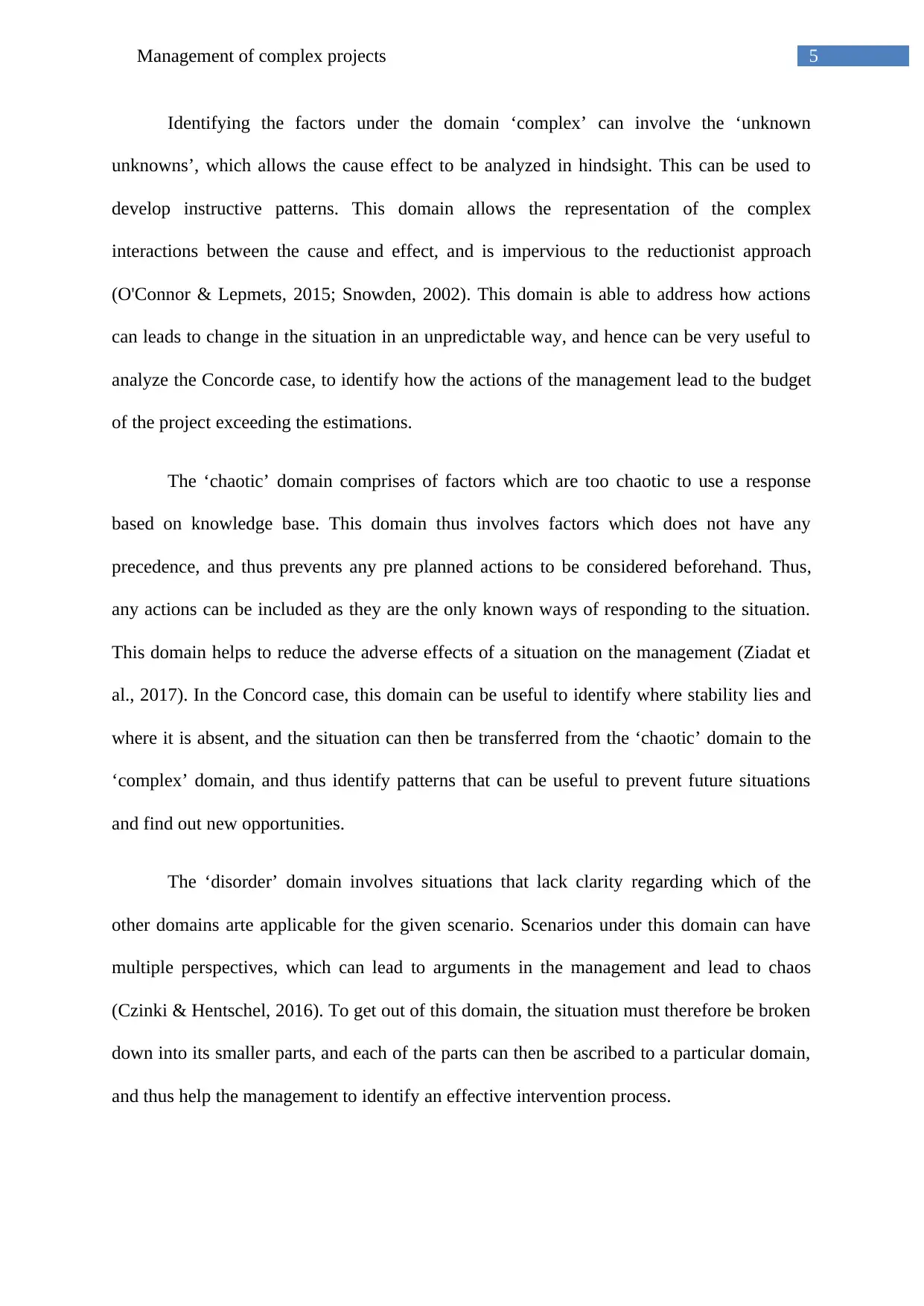
5Management of complex projects
Identifying the factors under the domain ‘complex’ can involve the ‘unknown
unknowns’, which allows the cause effect to be analyzed in hindsight. This can be used to
develop instructive patterns. This domain allows the representation of the complex
interactions between the cause and effect, and is impervious to the reductionist approach
(O'Connor & Lepmets, 2015; Snowden, 2002). This domain is able to address how actions
can leads to change in the situation in an unpredictable way, and hence can be very useful to
analyze the Concorde case, to identify how the actions of the management lead to the budget
of the project exceeding the estimations.
The ‘chaotic’ domain comprises of factors which are too chaotic to use a response
based on knowledge base. This domain thus involves factors which does not have any
precedence, and thus prevents any pre planned actions to be considered beforehand. Thus,
any actions can be included as they are the only known ways of responding to the situation.
This domain helps to reduce the adverse effects of a situation on the management (Ziadat et
al., 2017). In the Concord case, this domain can be useful to identify where stability lies and
where it is absent, and the situation can then be transferred from the ‘chaotic’ domain to the
‘complex’ domain, and thus identify patterns that can be useful to prevent future situations
and find out new opportunities.
The ‘disorder’ domain involves situations that lack clarity regarding which of the
other domains arte applicable for the given scenario. Scenarios under this domain can have
multiple perspectives, which can lead to arguments in the management and lead to chaos
(Czinki & Hentschel, 2016). To get out of this domain, the situation must therefore be broken
down into its smaller parts, and each of the parts can then be ascribed to a particular domain,
and thus help the management to identify an effective intervention process.
Identifying the factors under the domain ‘complex’ can involve the ‘unknown
unknowns’, which allows the cause effect to be analyzed in hindsight. This can be used to
develop instructive patterns. This domain allows the representation of the complex
interactions between the cause and effect, and is impervious to the reductionist approach
(O'Connor & Lepmets, 2015; Snowden, 2002). This domain is able to address how actions
can leads to change in the situation in an unpredictable way, and hence can be very useful to
analyze the Concorde case, to identify how the actions of the management lead to the budget
of the project exceeding the estimations.
The ‘chaotic’ domain comprises of factors which are too chaotic to use a response
based on knowledge base. This domain thus involves factors which does not have any
precedence, and thus prevents any pre planned actions to be considered beforehand. Thus,
any actions can be included as they are the only known ways of responding to the situation.
This domain helps to reduce the adverse effects of a situation on the management (Ziadat et
al., 2017). In the Concord case, this domain can be useful to identify where stability lies and
where it is absent, and the situation can then be transferred from the ‘chaotic’ domain to the
‘complex’ domain, and thus identify patterns that can be useful to prevent future situations
and find out new opportunities.
The ‘disorder’ domain involves situations that lack clarity regarding which of the
other domains arte applicable for the given scenario. Scenarios under this domain can have
multiple perspectives, which can lead to arguments in the management and lead to chaos
(Czinki & Hentschel, 2016). To get out of this domain, the situation must therefore be broken
down into its smaller parts, and each of the parts can then be ascribed to a particular domain,
and thus help the management to identify an effective intervention process.
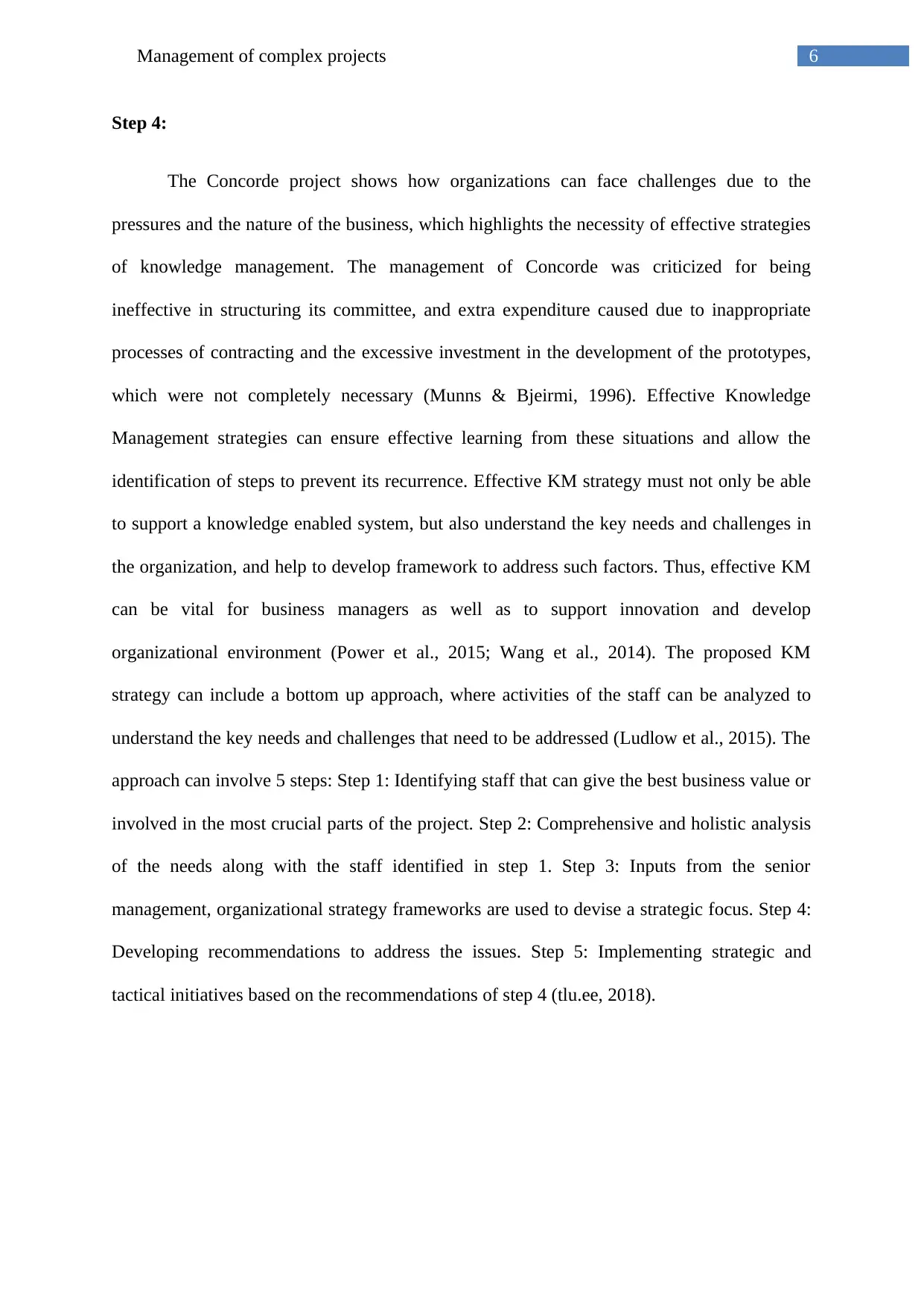
6Management of complex projects
Step 4:
The Concorde project shows how organizations can face challenges due to the
pressures and the nature of the business, which highlights the necessity of effective strategies
of knowledge management. The management of Concorde was criticized for being
ineffective in structuring its committee, and extra expenditure caused due to inappropriate
processes of contracting and the excessive investment in the development of the prototypes,
which were not completely necessary (Munns & Bjeirmi, 1996). Effective Knowledge
Management strategies can ensure effective learning from these situations and allow the
identification of steps to prevent its recurrence. Effective KM strategy must not only be able
to support a knowledge enabled system, but also understand the key needs and challenges in
the organization, and help to develop framework to address such factors. Thus, effective KM
can be vital for business managers as well as to support innovation and develop
organizational environment (Power et al., 2015; Wang et al., 2014). The proposed KM
strategy can include a bottom up approach, where activities of the staff can be analyzed to
understand the key needs and challenges that need to be addressed (Ludlow et al., 2015). The
approach can involve 5 steps: Step 1: Identifying staff that can give the best business value or
involved in the most crucial parts of the project. Step 2: Comprehensive and holistic analysis
of the needs along with the staff identified in step 1. Step 3: Inputs from the senior
management, organizational strategy frameworks are used to devise a strategic focus. Step 4:
Developing recommendations to address the issues. Step 5: Implementing strategic and
tactical initiatives based on the recommendations of step 4 (tlu.ee, 2018).
Step 4:
The Concorde project shows how organizations can face challenges due to the
pressures and the nature of the business, which highlights the necessity of effective strategies
of knowledge management. The management of Concorde was criticized for being
ineffective in structuring its committee, and extra expenditure caused due to inappropriate
processes of contracting and the excessive investment in the development of the prototypes,
which were not completely necessary (Munns & Bjeirmi, 1996). Effective Knowledge
Management strategies can ensure effective learning from these situations and allow the
identification of steps to prevent its recurrence. Effective KM strategy must not only be able
to support a knowledge enabled system, but also understand the key needs and challenges in
the organization, and help to develop framework to address such factors. Thus, effective KM
can be vital for business managers as well as to support innovation and develop
organizational environment (Power et al., 2015; Wang et al., 2014). The proposed KM
strategy can include a bottom up approach, where activities of the staff can be analyzed to
understand the key needs and challenges that need to be addressed (Ludlow et al., 2015). The
approach can involve 5 steps: Step 1: Identifying staff that can give the best business value or
involved in the most crucial parts of the project. Step 2: Comprehensive and holistic analysis
of the needs along with the staff identified in step 1. Step 3: Inputs from the senior
management, organizational strategy frameworks are used to devise a strategic focus. Step 4:
Developing recommendations to address the issues. Step 5: Implementing strategic and
tactical initiatives based on the recommendations of step 4 (tlu.ee, 2018).
Paraphrase This Document
Need a fresh take? Get an instant paraphrase of this document with our AI Paraphraser
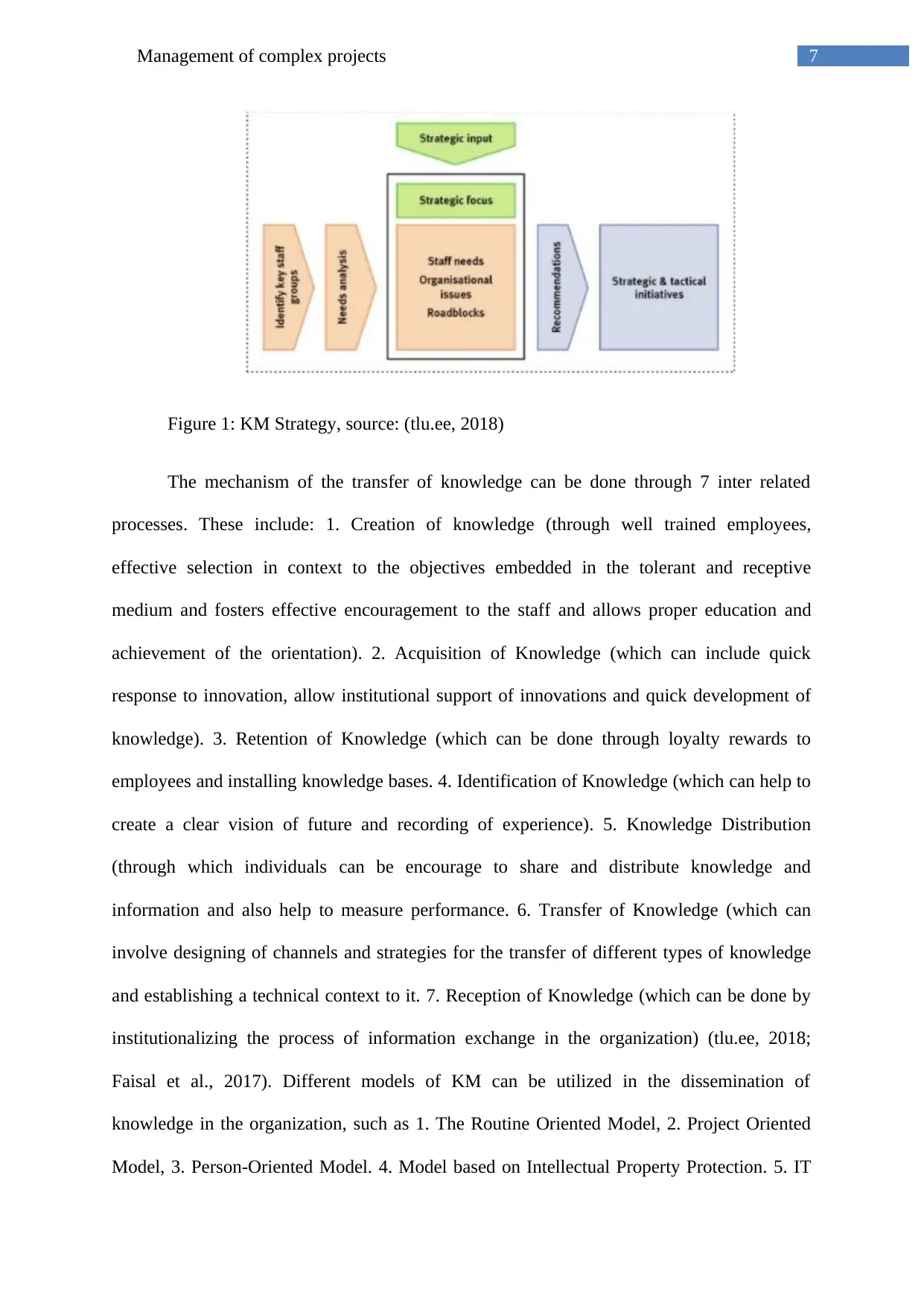
7Management of complex projects
Figure 1: KM Strategy, source: (tlu.ee, 2018)
The mechanism of the transfer of knowledge can be done through 7 inter related
processes. These include: 1. Creation of knowledge (through well trained employees,
effective selection in context to the objectives embedded in the tolerant and receptive
medium and fosters effective encouragement to the staff and allows proper education and
achievement of the orientation). 2. Acquisition of Knowledge (which can include quick
response to innovation, allow institutional support of innovations and quick development of
knowledge). 3. Retention of Knowledge (which can be done through loyalty rewards to
employees and installing knowledge bases. 4. Identification of Knowledge (which can help to
create a clear vision of future and recording of experience). 5. Knowledge Distribution
(through which individuals can be encourage to share and distribute knowledge and
information and also help to measure performance. 6. Transfer of Knowledge (which can
involve designing of channels and strategies for the transfer of different types of knowledge
and establishing a technical context to it. 7. Reception of Knowledge (which can be done by
institutionalizing the process of information exchange in the organization) (tlu.ee, 2018;
Faisal et al., 2017). Different models of KM can be utilized in the dissemination of
knowledge in the organization, such as 1. The Routine Oriented Model, 2. Project Oriented
Model, 3. Person-Oriented Model. 4. Model based on Intellectual Property Protection. 5. IT
Figure 1: KM Strategy, source: (tlu.ee, 2018)
The mechanism of the transfer of knowledge can be done through 7 inter related
processes. These include: 1. Creation of knowledge (through well trained employees,
effective selection in context to the objectives embedded in the tolerant and receptive
medium and fosters effective encouragement to the staff and allows proper education and
achievement of the orientation). 2. Acquisition of Knowledge (which can include quick
response to innovation, allow institutional support of innovations and quick development of
knowledge). 3. Retention of Knowledge (which can be done through loyalty rewards to
employees and installing knowledge bases. 4. Identification of Knowledge (which can help to
create a clear vision of future and recording of experience). 5. Knowledge Distribution
(through which individuals can be encourage to share and distribute knowledge and
information and also help to measure performance. 6. Transfer of Knowledge (which can
involve designing of channels and strategies for the transfer of different types of knowledge
and establishing a technical context to it. 7. Reception of Knowledge (which can be done by
institutionalizing the process of information exchange in the organization) (tlu.ee, 2018;
Faisal et al., 2017). Different models of KM can be utilized in the dissemination of
knowledge in the organization, such as 1. The Routine Oriented Model, 2. Project Oriented
Model, 3. Person-Oriented Model. 4. Model based on Intellectual Property Protection. 5. IT

8Management of complex projects
based Model. The strengths of the selected KM model include the strategically splitting of the
different situations into its component structures to facilitate learning (Argote & Ingram,
2000). It divides the process of knowledge management into steps which involves creation of
the knowledge, acquiring the knowledge created, retaining and then distributing the
knowledge which can then be transferred to others through channels of knowledge reception
and thus be utilized in the business. The weakness of the process is that it lengthens the
process of analyzing the knowledge, trying to strategize every information within the given
framework. For complicated knowledge, based on several etiologies, or knowledge that is
constantly evolving, identifying the various steps identified above can be a difficult process
(Sarala et al., 2016).
In complex process therefore, learning can be achieved through effective Knowledge
Management strategies, which can help to create a knowledge base of information, and thus
help to avoid situations being in the ‘disorder’ or ‘chaotic’ categories, and help to devise
strategies to avoid their recurrence. Effective knowledge management can also help in the
effective sharing of the best practices and information through the organization, thereby
fostering productivity and adherence of the business goals and objectives and maintain focus
of the project outlines (Kaszás et al., 2016). In the Concorde project, effective KM can be
helpful to understand how the various aspects have resulted in the underperformance of the
project, especially in relation to the over budgeting of the project, and help to identify
strategies that can be used to avoid such circumstances. This can foster an environment of
learning and excellence, where past mistakes are used as an opportunity to learn which is
further reinforced with knowledge gathered from research and literature, to build a stable
knowledge base, which can be used to inform managerial decisions of the organization.
However, this process can also complicate the process of acquiring simple knowledge which
has clear cause effect relations, as the management tries to calibrate the process according to
based Model. The strengths of the selected KM model include the strategically splitting of the
different situations into its component structures to facilitate learning (Argote & Ingram,
2000). It divides the process of knowledge management into steps which involves creation of
the knowledge, acquiring the knowledge created, retaining and then distributing the
knowledge which can then be transferred to others through channels of knowledge reception
and thus be utilized in the business. The weakness of the process is that it lengthens the
process of analyzing the knowledge, trying to strategize every information within the given
framework. For complicated knowledge, based on several etiologies, or knowledge that is
constantly evolving, identifying the various steps identified above can be a difficult process
(Sarala et al., 2016).
In complex process therefore, learning can be achieved through effective Knowledge
Management strategies, which can help to create a knowledge base of information, and thus
help to avoid situations being in the ‘disorder’ or ‘chaotic’ categories, and help to devise
strategies to avoid their recurrence. Effective knowledge management can also help in the
effective sharing of the best practices and information through the organization, thereby
fostering productivity and adherence of the business goals and objectives and maintain focus
of the project outlines (Kaszás et al., 2016). In the Concorde project, effective KM can be
helpful to understand how the various aspects have resulted in the underperformance of the
project, especially in relation to the over budgeting of the project, and help to identify
strategies that can be used to avoid such circumstances. This can foster an environment of
learning and excellence, where past mistakes are used as an opportunity to learn which is
further reinforced with knowledge gathered from research and literature, to build a stable
knowledge base, which can be used to inform managerial decisions of the organization.
However, this process can also complicate the process of acquiring simple knowledge which
has clear cause effect relations, as the management tries to calibrate the process according to
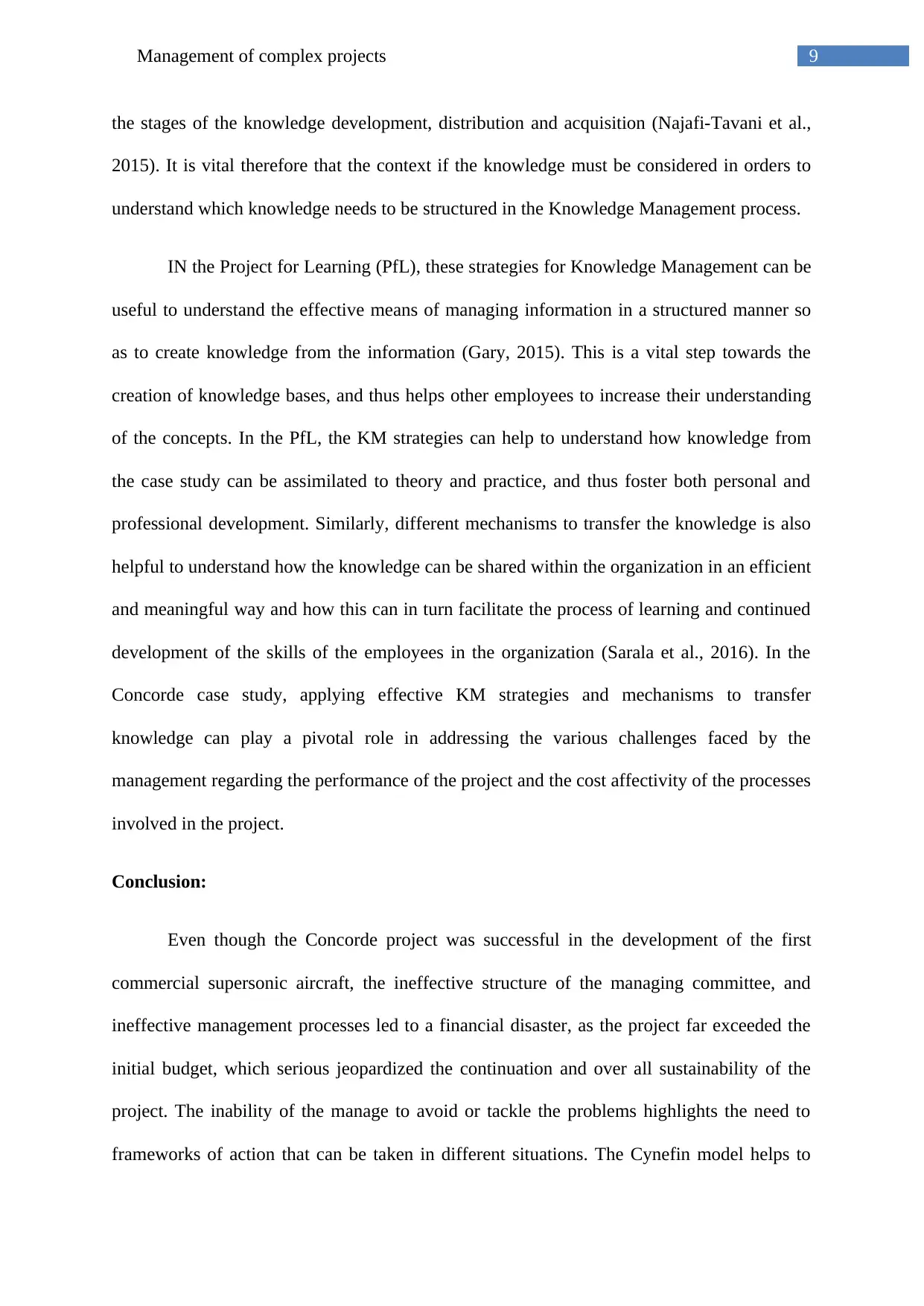
9Management of complex projects
the stages of the knowledge development, distribution and acquisition (Najafi-Tavani et al.,
2015). It is vital therefore that the context if the knowledge must be considered in orders to
understand which knowledge needs to be structured in the Knowledge Management process.
IN the Project for Learning (PfL), these strategies for Knowledge Management can be
useful to understand the effective means of managing information in a structured manner so
as to create knowledge from the information (Gary, 2015). This is a vital step towards the
creation of knowledge bases, and thus helps other employees to increase their understanding
of the concepts. In the PfL, the KM strategies can help to understand how knowledge from
the case study can be assimilated to theory and practice, and thus foster both personal and
professional development. Similarly, different mechanisms to transfer the knowledge is also
helpful to understand how the knowledge can be shared within the organization in an efficient
and meaningful way and how this can in turn facilitate the process of learning and continued
development of the skills of the employees in the organization (Sarala et al., 2016). In the
Concorde case study, applying effective KM strategies and mechanisms to transfer
knowledge can play a pivotal role in addressing the various challenges faced by the
management regarding the performance of the project and the cost affectivity of the processes
involved in the project.
Conclusion:
Even though the Concorde project was successful in the development of the first
commercial supersonic aircraft, the ineffective structure of the managing committee, and
ineffective management processes led to a financial disaster, as the project far exceeded the
initial budget, which serious jeopardized the continuation and over all sustainability of the
project. The inability of the manage to avoid or tackle the problems highlights the need to
frameworks of action that can be taken in different situations. The Cynefin model helps to
the stages of the knowledge development, distribution and acquisition (Najafi-Tavani et al.,
2015). It is vital therefore that the context if the knowledge must be considered in orders to
understand which knowledge needs to be structured in the Knowledge Management process.
IN the Project for Learning (PfL), these strategies for Knowledge Management can be
useful to understand the effective means of managing information in a structured manner so
as to create knowledge from the information (Gary, 2015). This is a vital step towards the
creation of knowledge bases, and thus helps other employees to increase their understanding
of the concepts. In the PfL, the KM strategies can help to understand how knowledge from
the case study can be assimilated to theory and practice, and thus foster both personal and
professional development. Similarly, different mechanisms to transfer the knowledge is also
helpful to understand how the knowledge can be shared within the organization in an efficient
and meaningful way and how this can in turn facilitate the process of learning and continued
development of the skills of the employees in the organization (Sarala et al., 2016). In the
Concorde case study, applying effective KM strategies and mechanisms to transfer
knowledge can play a pivotal role in addressing the various challenges faced by the
management regarding the performance of the project and the cost affectivity of the processes
involved in the project.
Conclusion:
Even though the Concorde project was successful in the development of the first
commercial supersonic aircraft, the ineffective structure of the managing committee, and
ineffective management processes led to a financial disaster, as the project far exceeded the
initial budget, which serious jeopardized the continuation and over all sustainability of the
project. The inability of the manage to avoid or tackle the problems highlights the need to
frameworks of action that can be taken in different situations. The Cynefin model helps to
Secure Best Marks with AI Grader
Need help grading? Try our AI Grader for instant feedback on your assignments.
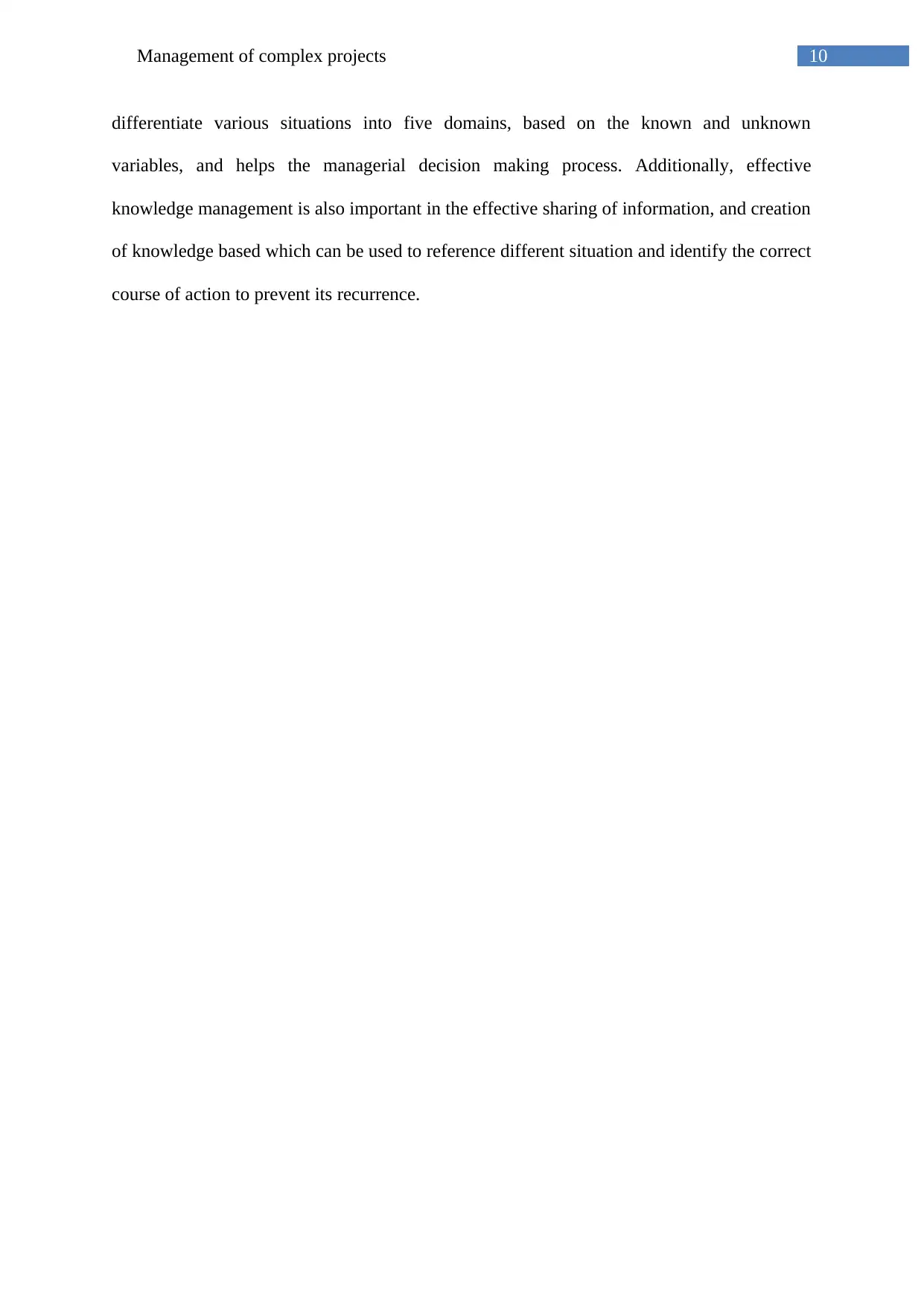
10Management of complex projects
differentiate various situations into five domains, based on the known and unknown
variables, and helps the managerial decision making process. Additionally, effective
knowledge management is also important in the effective sharing of information, and creation
of knowledge based which can be used to reference different situation and identify the correct
course of action to prevent its recurrence.
differentiate various situations into five domains, based on the known and unknown
variables, and helps the managerial decision making process. Additionally, effective
knowledge management is also important in the effective sharing of information, and creation
of knowledge based which can be used to reference different situation and identify the correct
course of action to prevent its recurrence.

11Management of complex projects
References:
Argote, L., & Ingram, P. (2000). Knowledge transfer: A basis for competitive advantage in
firms. Organizational behavior and human decision processes, 82(1), 150-169.
Czinki, A., & Hentschel, C. (2016). Solving complex problems and TRIZ. Procedia
CIRP, 39, 27-32.
Faisal, R., Chong, A. L., & Yee, A. S. V. (2017). Systematic Review of Sustainable
Knowledge Transfer Process in Government-Industry-Academia Consortium. Asian
Journal of Innovation and Policy, 6, 295-312.
Gary, K. (2015). Project-based learning. Computer, 48(9), 98-100.
Kaszás, N., Peter, E., Keller, K., & Kovács, T. (2016). Boundless opportunities with definite
limitations. Deturope-The Central European Journal Of Regional Development And
Tourism, 8(1), 5-20.
Ludlow, D., Khan, Z., Soomro, K., Marconcini, M., José, R. S., Malcorps, P., ... & Metz, A.
(2017). From top-down land use planning intelligence to bottom-up stakeholder
engagement for smart cities-a case study: DECUMANUS service
products. International Journal of Services Technology and Management, 23(5-6),
465-493.
Morris, P. W., & Hough, G. H. (1987). The anatomy of major projects: A study of the reality
of project management.
Munns, A. K., & Bjeirmi, B. F. (1996). The role of project management in achieving project
success. International journal of project management, 14(2), 81-87.
References:
Argote, L., & Ingram, P. (2000). Knowledge transfer: A basis for competitive advantage in
firms. Organizational behavior and human decision processes, 82(1), 150-169.
Czinki, A., & Hentschel, C. (2016). Solving complex problems and TRIZ. Procedia
CIRP, 39, 27-32.
Faisal, R., Chong, A. L., & Yee, A. S. V. (2017). Systematic Review of Sustainable
Knowledge Transfer Process in Government-Industry-Academia Consortium. Asian
Journal of Innovation and Policy, 6, 295-312.
Gary, K. (2015). Project-based learning. Computer, 48(9), 98-100.
Kaszás, N., Peter, E., Keller, K., & Kovács, T. (2016). Boundless opportunities with definite
limitations. Deturope-The Central European Journal Of Regional Development And
Tourism, 8(1), 5-20.
Ludlow, D., Khan, Z., Soomro, K., Marconcini, M., José, R. S., Malcorps, P., ... & Metz, A.
(2017). From top-down land use planning intelligence to bottom-up stakeholder
engagement for smart cities-a case study: DECUMANUS service
products. International Journal of Services Technology and Management, 23(5-6),
465-493.
Morris, P. W., & Hough, G. H. (1987). The anatomy of major projects: A study of the reality
of project management.
Munns, A. K., & Bjeirmi, B. F. (1996). The role of project management in achieving project
success. International journal of project management, 14(2), 81-87.
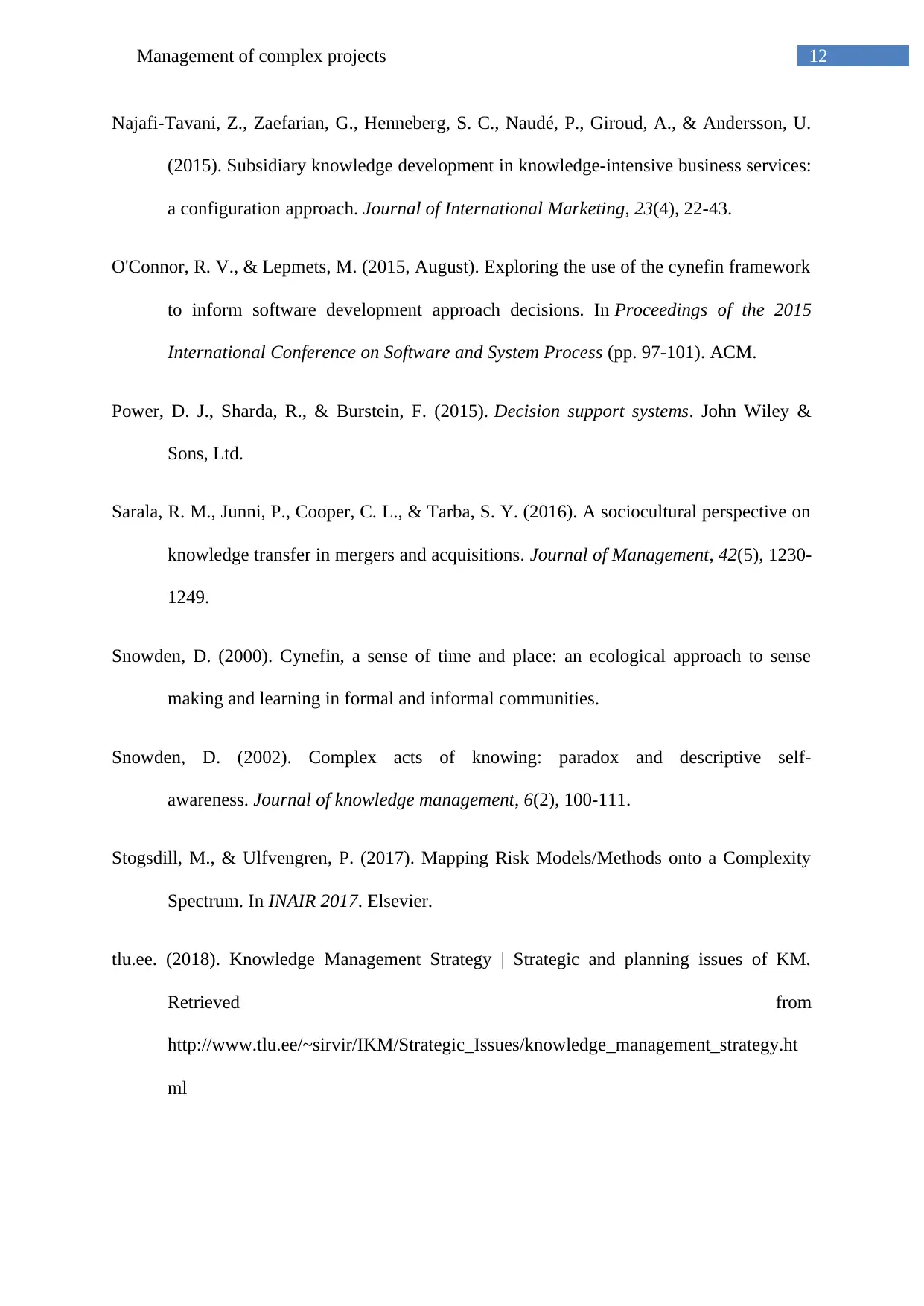
12Management of complex projects
Najafi-Tavani, Z., Zaefarian, G., Henneberg, S. C., Naudé, P., Giroud, A., & Andersson, U.
(2015). Subsidiary knowledge development in knowledge-intensive business services:
a configuration approach. Journal of International Marketing, 23(4), 22-43.
O'Connor, R. V., & Lepmets, M. (2015, August). Exploring the use of the cynefin framework
to inform software development approach decisions. In Proceedings of the 2015
International Conference on Software and System Process (pp. 97-101). ACM.
Power, D. J., Sharda, R., & Burstein, F. (2015). Decision support systems. John Wiley &
Sons, Ltd.
Sarala, R. M., Junni, P., Cooper, C. L., & Tarba, S. Y. (2016). A sociocultural perspective on
knowledge transfer in mergers and acquisitions. Journal of Management, 42(5), 1230-
1249.
Snowden, D. (2000). Cynefin, a sense of time and place: an ecological approach to sense
making and learning in formal and informal communities.
Snowden, D. (2002). Complex acts of knowing: paradox and descriptive self-
awareness. Journal of knowledge management, 6(2), 100-111.
Stogsdill, M., & Ulfvengren, P. (2017). Mapping Risk Models/Methods onto a Complexity
Spectrum. In INAIR 2017. Elsevier.
tlu.ee. (2018). Knowledge Management Strategy | Strategic and planning issues of KM.
Retrieved from
http://www.tlu.ee/~sirvir/IKM/Strategic_Issues/knowledge_management_strategy.ht
ml
Najafi-Tavani, Z., Zaefarian, G., Henneberg, S. C., Naudé, P., Giroud, A., & Andersson, U.
(2015). Subsidiary knowledge development in knowledge-intensive business services:
a configuration approach. Journal of International Marketing, 23(4), 22-43.
O'Connor, R. V., & Lepmets, M. (2015, August). Exploring the use of the cynefin framework
to inform software development approach decisions. In Proceedings of the 2015
International Conference on Software and System Process (pp. 97-101). ACM.
Power, D. J., Sharda, R., & Burstein, F. (2015). Decision support systems. John Wiley &
Sons, Ltd.
Sarala, R. M., Junni, P., Cooper, C. L., & Tarba, S. Y. (2016). A sociocultural perspective on
knowledge transfer in mergers and acquisitions. Journal of Management, 42(5), 1230-
1249.
Snowden, D. (2000). Cynefin, a sense of time and place: an ecological approach to sense
making and learning in formal and informal communities.
Snowden, D. (2002). Complex acts of knowing: paradox and descriptive self-
awareness. Journal of knowledge management, 6(2), 100-111.
Stogsdill, M., & Ulfvengren, P. (2017). Mapping Risk Models/Methods onto a Complexity
Spectrum. In INAIR 2017. Elsevier.
tlu.ee. (2018). Knowledge Management Strategy | Strategic and planning issues of KM.
Retrieved from
http://www.tlu.ee/~sirvir/IKM/Strategic_Issues/knowledge_management_strategy.ht
ml
Paraphrase This Document
Need a fresh take? Get an instant paraphrase of this document with our AI Paraphraser
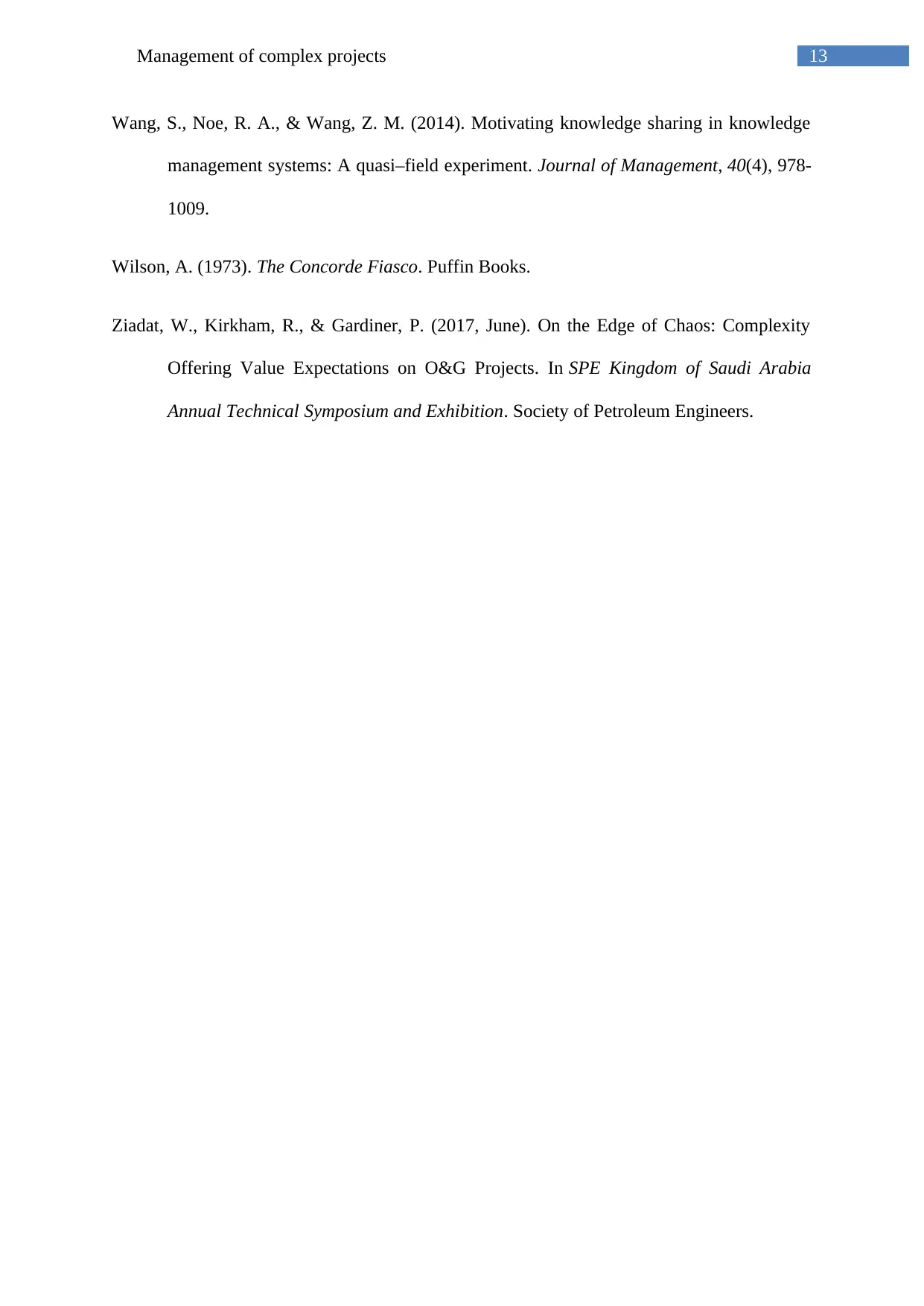
13Management of complex projects
Wang, S., Noe, R. A., & Wang, Z. M. (2014). Motivating knowledge sharing in knowledge
management systems: A quasi–field experiment. Journal of Management, 40(4), 978-
1009.
Wilson, A. (1973). The Concorde Fiasco. Puffin Books.
Ziadat, W., Kirkham, R., & Gardiner, P. (2017, June). On the Edge of Chaos: Complexity
Offering Value Expectations on O&G Projects. In SPE Kingdom of Saudi Arabia
Annual Technical Symposium and Exhibition. Society of Petroleum Engineers.
Wang, S., Noe, R. A., & Wang, Z. M. (2014). Motivating knowledge sharing in knowledge
management systems: A quasi–field experiment. Journal of Management, 40(4), 978-
1009.
Wilson, A. (1973). The Concorde Fiasco. Puffin Books.
Ziadat, W., Kirkham, R., & Gardiner, P. (2017, June). On the Edge of Chaos: Complexity
Offering Value Expectations on O&G Projects. In SPE Kingdom of Saudi Arabia
Annual Technical Symposium and Exhibition. Society of Petroleum Engineers.
1 out of 14
Related Documents
Your All-in-One AI-Powered Toolkit for Academic Success.
+13062052269
info@desklib.com
Available 24*7 on WhatsApp / Email
![[object Object]](/_next/static/media/star-bottom.7253800d.svg)
Unlock your academic potential
© 2024 | Zucol Services PVT LTD | All rights reserved.